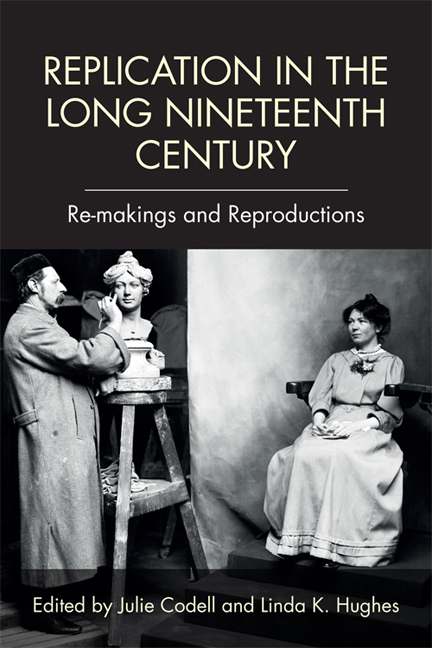Book contents
- Frontmatter
- Contents
- List of Illustrations
- Acknowledgments
- 1 Introduction: Replication in the Long Nineteenth Century – Re-makings and Reproductions
- I Replication and Networks
- 2 Replication of Things: The Case for Composite Biographical Approaches
- 3 Transatlantic Autograph Replicas and the Uplifting of American Culture
- 4 “Petty Larceny” and “Manufactured Science”: Nineteenth-Century Parasitology and the Politics of Replication
- 5 Portraying and Performing the Copy, c. 1900
- II Replication and Technology
- III Replication and Authenticity
- IV Replication and Time
- Notes on Contributors
- Index
2 - Replication of Things: The Case for Composite Biographical Approaches
from I - Replication and Networks
Published online by Cambridge University Press: 11 August 2018
- Frontmatter
- Contents
- List of Illustrations
- Acknowledgments
- 1 Introduction: Replication in the Long Nineteenth Century – Re-makings and Reproductions
- I Replication and Networks
- 2 Replication of Things: The Case for Composite Biographical Approaches
- 3 Transatlantic Autograph Replicas and the Uplifting of American Culture
- 4 “Petty Larceny” and “Manufactured Science”: Nineteenth-Century Parasitology and the Politics of Replication
- 5 Portraying and Performing the Copy, c. 1900
- II Replication and Technology
- III Replication and Authenticity
- IV Replication and Time
- Notes on Contributors
- Index
Summary
Introduction
The subject of this chapter is what are now anachronistically referred to as “replicas” of archaeological material from the long nineteenth century, generally referred to at the time of their creation as “reproductions,” “facsimiles,” or occasionally “models.” Focusing on copies of early medieval (post-Roman / pre-Romanesque) material culture, and drawing on case studies from Scotland, I will consider the broader merits of a biographical approach to the study of replicas – as authentic things in their own right and as part of the composite biographies of the original and all its reproductions. The approach advocated here has relevance and application anywhere in the world that replicas were or continue to be created, and where present-day society needs to understand and be able to assess critically their contemporary value, significance, and authenticity. The objects that form the focus of this study were primarily made for and by antiquarians and museums whose aspiration was that these were exact copies of the shape, if not the precise color and texture, of their subjects. There was never any pretense that they were the originals but in due course they came to be regarded as inauthentic because of the prevalence of the idea, now challenged, that authenticity is a property bound up with the intrinsic fabric of the thing (Jones 2010: 182).
The production and exhibition of replicas of archaeological material was a very significant and serious enterprise for museums and international fairs, particularly between the Great Exhibition of 1851 in London and the First World War. Indeed, living in a world of reproductions and replicas has been seen as a defining attribute of late nineteenth-century culture in general (Orvell xv, 39). In museums they were intended for observation, education, handling, documentation, presentation, and art training, not least as part of a concerted effort to improve the quality of industrial design and the taste of nations through the advocacy of universal principles of art. The reproductive media embraced the technologies and craft of plaster casts, electrotypes, fictile ivories, architectural models, watercolor copies of medieval stained glass, brass rubbings, paper mosaics, and, particularly from the 1850s onwards, photographs (Baker).
- Type
- Chapter
- Information
- Replication in the Long Nineteenth CenturyRe-makings and Reproductions, pp. 23 - 45Publisher: Edinburgh University PressPrint publication year: 2017

